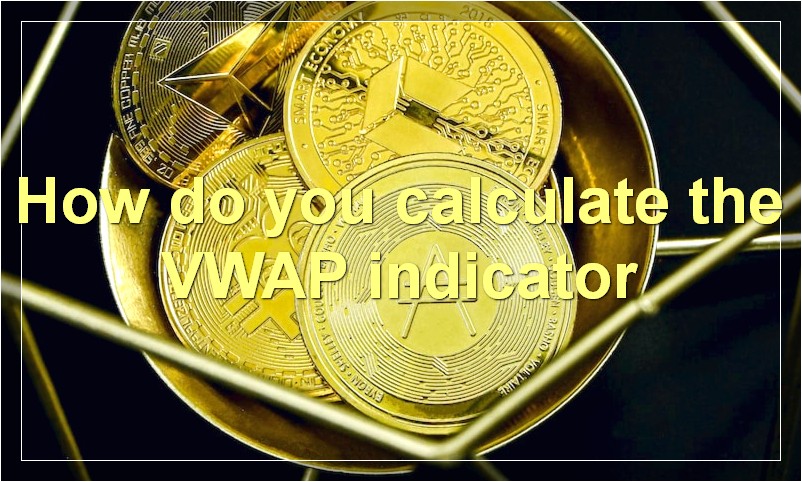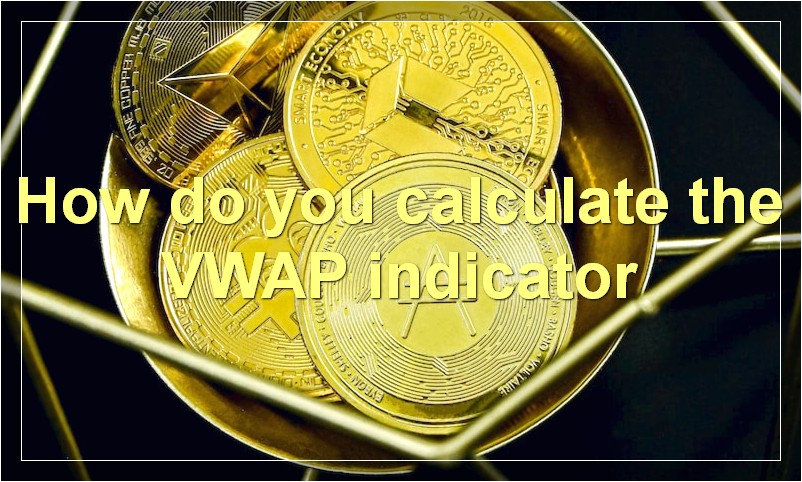If you’re a day trader, then you know that finding the right indicators is essential to your success. But with so many options out there, it can be tough to know where to start. That’s why we’re here to help you out. In this article, we’re going to show you how to use the VWAP indicator to your advantage.
What is the VWAP indicator
The VWAP indicator is a tool that can be used by day traders to help make trading decisions. The VWAP stands for volume-weighted average price, and is calculated by taking the average price of a security over a given period of time and weighting it according to the volume of shares traded during that time.
For example, let’s say that ABC Company stock is trading at $10 per share, and the average daily volume over the past week has been 100,000 shares. The VWAP would be calculated as follows: ($10 x 100,000) / 100,000 = $10. In other words, the VWAP is simply the average price of a security over a given period of time.
The VWAP indicator can be used in a number of ways, but one common use is to help identify whether a security is trading at a discount or premium to its average price. For example, if ABC Company stock is currently trading at $9 per share, that would be considered a discount to its VWAP of $10. Conversely, if the stock is trading at $11 per share, that would be considered a premium.
Another common use for the VWAP indicator is to help with trade execution. For example, let’s say you wanted to buy 1,000 shares of ABC Company stock. You could place an order to buy at the current market price, which might be $10 per share. Or, you could place an order to buy at the VWAP price, which in this case would also be $10 per share.
The main advantage of using the VWAP price is that it takes into account the volume of shares traded, and therefore gives you a more accurate picture of where the “true” price of the security lies. This can be especially helpful when trying to execute large trades, as it can help you avoid paying too much or selling too low.
Overall, the VWAP indicator is a useful tool for day traders that can be used in a number of different ways. If you’re looking to buy or sell a security, placing an order at the VWAP price can help ensure you get a fair price. And if you’re trying to determine whether a security is trading at a discount or premium to its average price, the VWAP can be a helpful guide.
How do you calculate the VWAP indicator

The VWAP indicator is a tool that traders can use to measure the average price of a security over a given period of time. The VWAP indicator can be used on any time frame, but is most commonly used on daily charts.
To calculate the VWAP indicator, you will need to know the following:
The security’s opening price
The security’s closing price
The volume of the security traded during the day
Once you have this information, you can calculate the VWAP using the following formula:
VWAP = (Opening Price x Volume) + (Closing Price x Volume) / 2
For example, let’s say that you are looking at the VWAP for XYZ stock. XYZ stock has an opening price of $10.00, a closing price of $10.50, and traded 100,000 shares during the day. Using the formula above, we can calculate the VWAP for XYZ stock as follows:
VWAP = ($10.00 x 100,000) + ($10.50 x 100,000) / 2
VWAP = $1,005,000 + $1,050,000 / 2
VWAP = $2,055,000 / 2
VWAP = $1,027.50
What is the difference between VWAP and other moving averages
There are a few key differences between VWAP and other moving averages. First, VWAP is volume-weighted, meaning that it gives more weight to periods of high trading volume. This makes it more accurate than other moving averages in predicting price trends. Second, VWAP is calculated using all trading activity for the day, while other moving averages only consider a certain number of data points. This makes VWAP less susceptible to spikes or dips in the market. Finally, VWAP is constantly updated throughout the day, while other moving averages are only calculated at the end of the day.
When is the best time to use the VWAP indicator
The VWAP indicator can be used to help traders make decisions about when to enter and exit trades. VWAP stands for volume-weighted average price, and is a technical analysis tool that is used to measure the average price of a security over a given period of time.VWAP is calculated by taking the total dollar value of all trades in a security and dividing it by the total number of shares traded.
The indicator can be used on any timeframe, but is most commonly used on intraday charts. When using VWAP on an intraday chart, traders will often look for times when the price is trading above or below VWAP. If the price is above VWAP, traders may consider buying the security, as they believe the price will continue to rise. If the price is below VWAP, traders may consider selling the security, as they believe the price will continue to fall.
In addition to helping traders make decisions about when to enter and exit trades, VWAP can also be used as a trailing stop loss. A trailing stop loss is an order that is placed at a certain percentage below the current market price. For example, if a trader bought a stock at $100 per share and placed a trailing stop loss order at 10%, their order would be triggered if the stock fell to $90 per share.
While VWAP is a useful indicator, it is important to remember that it is just one tool that should be used in conjunction with other technical indicators and fundamental analysis.
How can the VWAP indicator be used in trading
The VWAP indicator can be used in trading by taking the volume-weighted average price of a security over a specific period of time. This period can be an intraday, daily, weekly, or monthly timeframe. The VWAP calculation is generally used by traders to help assess the current market value of a security, as well as to make informed decisions about where to enter and exit trades.
There are a few different ways that the VWAP indicator can be used in trading. One way is to use VWAP as a point of reference for determining whether a security is currently undervalued or overvalued. If the current price of a security is trading below VWAP, it may be considered undervalued, and vice versa if it is trading above VWAP. Another way to use VWAP is as a trailing stop-loss level. This means that if the price of a security falls below VWAP, it may be indicative of downward momentum, and a trader may consider exiting their position.
VWAP can also be used as a support or resistance level. If the price of a security is approaching VWAP from below and then stalls or reverses, this may be seen as an indication of resistance at VWAP. Similarly, if the price is approaching VWAP from above and then stalls or reverses, this may be seen as an indication of support at VWAP.
While the VWAP indicator can be a helpful tool for traders, it is important to keep in mind that it should not be used in isolation. Rather, it should be used in conjunction with other technical indicators and forms of analysis in order to get a more complete picture of the market.
What are some common VWAP trading strategies

There are a few different types of VWAP trading strategies that traders use. The first is the intraday VWAP strategy, which uses the VWAP to trade during the day. The second is the end-of-day VWAP strategy, which uses the VWAP to trade at the end of the day. And the third is the multi-day VWAP strategy, which uses the VWAP to trade over multiple days.
The intraday VWAP strategy is the most common type of VWAP trading strategy. It’s also the simplest to understand and implement. This strategy involves buying or selling when the price moves above or below the VWAP.
The end-of-day VWAP strategy is a bit more complex than the intraday VWAP strategy. This strategy involves waiting for the price to move above or below the VWAP, and then entering a trade at the end of the day.
The multi-day VWAP strategy is the most complex of all the VWAP trading strategies. This strategy involves using the VWAP to trade over multiple days. This can be done by either buying when the price moves below the VWAP and selling when it moves above the VWAP, or by selling when the price moves below the VWAP and buying when it moves above the VWAP.
What are the benefits of using the VWAP indicator
There are many benefits of using the VWAP indicator, but the three main benefits are that it can help you find the best entry point, it is less subject to market manipulation, and it can help you predict future price movements.
1. The VWAP indicator can help you find the best entry point.
If you are looking for the best time to buy a stock, then using the VWAP indicator can help you find the right entry point. The VWAP indicator takes into account the volume of trades that have been made throughout the day, so it can give you an idea of where the stock is likely to trade in the future. This means that if you see a stock trading at a certain price and the VWAP indicator is telling you that it is undervalued, then this could be the perfect time to buy.
2. The VWAP indicator is less subject to market manipulation.
One of the problems with using technical indicators is that they can be easily manipulated by traders. For example, if a trader wants to artificially increase the price of a stock, they could do this by creating a lot of fake buy orders near the current price. This would cause the stock price to spike up and would fool other traders into thinking that there was real demand for the stock. However, because the VWAP indicator takes into account the volume of trades, it is much harder to manipulate. This means that you can trust the VWAP indicator more than you could trust other technical indicators.
3. The VWAP indicator can help you predict future price movements.
By taking into account the volume of trades, the VWAP indicator can give you an idea of where the stock price is likely to go in the future. If there is high volume during a certain period, then this usually means that there is a lot of buying or selling happening and so the stock price is likely to move in that direction. However, if there is low volume, then this usually means that there isn’t much activity and so the stock price is likely to remain stable. By using the VWAP indicator, you can get an idea of which way the stock price is likely to move and make your trading decisions accordingly.
Are there any drawbacks to using the VWAP indicator
There are a few potential drawbacks to using the VWAP indicator. First, VWAP can be lagging, so it may not provide the most timely signal. Second, because VWAP is based on volume, it may not be as accurate during periods of low volume trading. Finally, some traders believe that VWAP is best used as a confirmation tool rather than a primary entry/exit signal, so it may not be suited for all trading strategies.
How do I add the VWAP indicator to my trading platform
Adding the VWAP indicator to your trading platform is a simple process. First, you need to find the indicator in the ‘Indicators’ menu. Second, you need to select the timeframe that you want the indicator to be displayed on. Third, you need to add the VWAP indicator to your chart. Fourth, you need to adjust the settings of the VWAP indicator to your liking. Finally, you need to apply the VWAP indicator to your chart.
What are some tips for using the VWAP indicator effectively
The volume weighted average price (VWAP) is a technical indicator used by traders to determine the mean price of a security over a set period of time. The VWAP is calculated by adding up the total dollar value of all transactions in a security and dividing it by the total number of shares traded.
Some tips for using the VWAP indicator effectively include:
– using it as a reference point to buy or sell a security,
– incorporating it into trading strategies, and
– monitoring it throughout the day to identify changes in market trends.
When used correctly, the VWAP can be a helpful tool for traders in making informed decisions about when to buy or sell a security.

